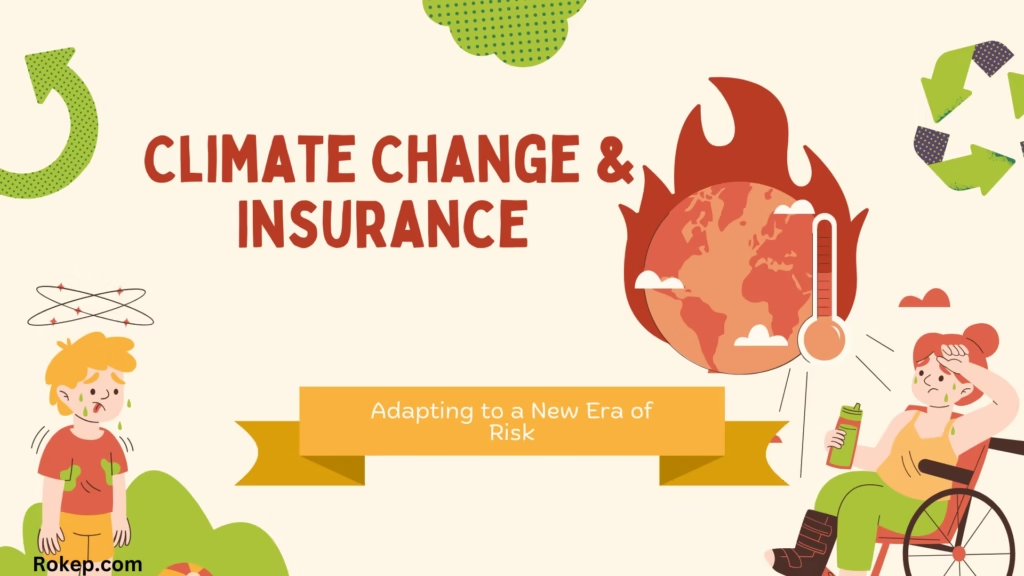The world is facing an unprecedented shift in environmental conditions due to climate change. Extreme weather events such as hurricanes, wildfires, floods, and heatwaves are becoming more frequent and severe, creating new challenges for industries and individuals alike. One of the sectors most impacted by these changes is the insurance industry, which is grappling with how to adapt to this rapidly evolving landscape of risk. As climate change continues to reshape the natural world, the insurance market is responding with higher premiums, new policies, and innovative risk management strategies to address the environmental hazards of the 21st century.
The Growing Influence of Climate Change on Insurance
Insurance companies are risk-based businesses, and their role is to assess and manage the potential financial fallout from unforeseen events. Traditionally, the industry has relied on historical data to model the frequency and severity of risks, helping insurers set premiums and terms for policies. However, as the effects of climate change become more pronounced, this historical data is no longer as reliable a predictor of future risk.
The rise in extreme weather events has made it clear that the risks associated with natural disasters are increasing, forcing insurers to adapt their strategies. According to the National Oceanic and Atmospheric Administration (NOAA), 2023 marked another year of record-breaking weather events in the United States. The frequency and intensity of hurricanes, wildfires, and floods have all contributed to the increased risk faced by both policyholders and insurers alike. As a result, many insurance companies are adjusting their coverage offerings and pricing models to reflect the growing exposure to these environmental threats.
One of the clearest indicators of this shift is the steady rise in insurance premiums. In the wake of major natural disasters, insurers must contend with larger payouts and increasingly uncertain risk projections. This has led to a cycle of rising premiums across the board, which in turn makes insurance more expensive and sometimes inaccessible for individuals and businesses. For example, homeowners living in high-risk areas for flooding or wildfires are finding that their premiums are rising sharply, as insurers factor in the growing threat posed by these climate-induced hazards.
Rising Premiums and the Impact on Consumers
As the severity of climate-related risks increases, insurers are faced with the difficult task of pricing policies accurately while maintaining profitability. This challenge has led to a rise in premiums for many types of coverage, particularly in regions prone to natural disasters. The cost of homeowners insurance, for instance, has surged in areas vulnerable to hurricanes, floods, and wildfires.
In California, for example, the combination of persistent drought conditions, extreme heat, and devastating wildfires has caused a significant rise in home insurance premiums. According to the California Department of Insurance, the state has seen a dramatic increase in premiums, with some homeowners seeing their insurance costs more than double in recent years. In some cases, insurance companies have even stopped offering policies in high-risk areas, leaving homeowners with limited options.
The impact of rising premiums is not limited to homeowners. Businesses, too, are facing higher costs for commercial property and liability insurance, particularly in sectors vulnerable to climate-related disruptions. Agriculture, real estate, and tourism industries are particularly hard-hit, as extreme weather events can damage infrastructure, disrupt supply chains, and create economic instability. As a result, companies are finding it more difficult to secure affordable coverage, which can lead to a reduction in investment or even forced closures in extreme cases.
For consumers, these higher premiums can be financially burdensome. The additional costs often put a strain on household budgets, and many individuals and businesses are forced to make tough decisions about the level of coverage they can afford. Some may choose to underinsured their properties, leaving them vulnerable to catastrophic losses in the event of a natural disaster. Others may opt for high-deductible policies, which can reduce premium costs but increase out-of-pocket expenses in the event of a claim.

New Policies and Innovations in Risk Management
In response to the changing landscape of risk, insurers are increasingly focusing on developing new policies and risk management strategies that address the unique challenges posed by climate change. One key area of innovation is the development of climate-specific insurance policies, such as flood insurance, wildfire insurance, and coverage for businesses affected by climate-related disruptions.
Flood insurance is a prime example of a climate-related insurance innovation. In the past, many homeowners were not required to carry flood insurance, and the coverage was often excluded from standard homeowners policies. However, as the risk of flooding has increased due to rising sea levels and more intense storms, insurers have begun offering specialized flood insurance products. The Federal Emergency Management Agency (FEMA) also plays a role in providing flood insurance through the National Flood Insurance Program (NFIP), which has been expanded to help mitigate the financial risks associated with flooding.
Another area of innovation is the development of parametric insurance products, which are designed to provide quicker payouts after a disaster. Unlike traditional insurance policies, which require a detailed claims process, parametric insurance is based on predefined triggers, such as the intensity of a hurricane or the amount of rainfall in a given area. If the specified trigger is met, the policyholder receives a payout, regardless of the actual damage. This model is gaining traction in regions where natural disasters are frequent and where traditional claims processes may be slow or inefficient.
In addition to new policy offerings, insurers are also incorporating advanced technology and data analytics to improve risk assessment and management. For instance, satellite imagery, weather data, and artificial intelligence (AI) are being used to monitor and predict climate-related risks in real time. By leveraging this technology, insurers can better understand the potential exposure of specific properties and adjust premiums accordingly. This data-driven approach enables insurers to make more informed decisions about risk pricing and allows them to offer customized policies that reflect the unique risks faced by each individual or business.
Government Response and Regulation
The increasing impact of climate change on the insurance industry has prompted governments around the world to take action. In the U.S., the federal government plays a critical role in managing risk through programs like the NFIP, which provides flood insurance to homeowners and businesses in flood-prone areas. However, the growing financial burden of flood insurance has raised concerns about the long-term sustainability of the program. In recent years, FEMA has worked to update flood risk maps and adjust premiums to better reflect the changing reality of climate-related risks.
State governments are also stepping in to address the challenges facing the insurance industry. For example, California has enacted regulations aimed at reducing the exposure of insurers to wildfire risk. These regulations require insurers to take steps to mitigate the potential damage caused by wildfires, such as offering discounts for fire-resistant home improvements and encouraging the creation of defensible space around properties. However, these regulations are not always enough to keep pace with the rapidly evolving risks posed by climate change.
At the international level, governments and regulators are working to develop frameworks for managing the financial risks associated with climate change. The Task Force on Climate-related Financial Disclosures (TCFD), established by the Financial Stability Board, has been instrumental in encouraging companies, including insurers, to disclose their exposure to climate-related risks. The TCFD’s guidelines provide a framework for assessing and reporting on the potential financial impacts of climate change, which helps insurers and other financial institutions better understand and manage their risk exposure.
Looking Ahead: The Future of Climate Change and Insurance
As the effects of climate change continue to unfold, the insurance industry will need to adapt to new realities. Rising premiums, changes in policy offerings, and innovative risk management strategies are just the beginning of what is likely to be a long-term transformation of the industry. Insurance companies will need to work closely with governments, businesses, and consumers to develop sustainable solutions that address the growing risks posed by climate change.
One of the most important challenges will be ensuring that insurance remains accessible and affordable for all. While it’s essential for insurers to account for the increasing risks of climate change, it’s equally important to avoid pricing out vulnerable communities or sectors. Balancing the need for financial sustainability with the goal of providing widespread access to coverage will be a critical factor in the evolution of the insurance industry in the coming years.
Ultimately, the insurance sector will play a key role in helping society navigate the challenges of a changing climate. By developing innovative policies, utilizing advanced technologies, and working in partnership with governments and businesses, insurers can help mitigate the financial risks of climate change while promoting resilience and sustainability.
For more information on how climate change is affecting insurance markets, you can refer to resources like the National Oceanic and Atmospheric Administration (NOAA) here and FEMA’s National Flood Insurance Program.
